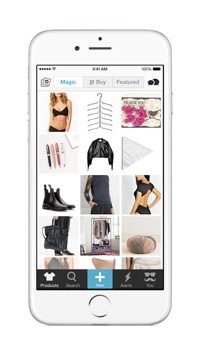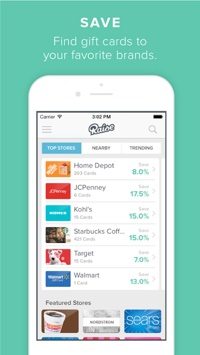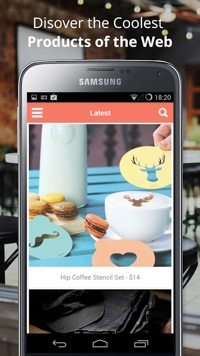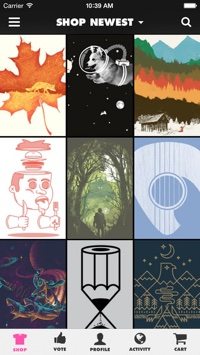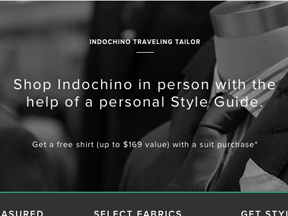Mobile commerce is no longer a novelty. According to an IBM report, mobile accounted for 45 percent of all online traffic during the 2014 holiday season, and online sales from mobile devices accounted for 22.6 percent of the total. Smartphones and tablets are having a meaningful impact on how we purchase, and some mobile commerce apps are even reshaping traditional businesses.
Here is a list of innovative mobile commerce apps. Several of the apps are marketplaces or help users to discover new products. There are also some ingenious apps that redefine how we purchase daily goods and services.
Spring
Spring offers an Instagram-like photo feed of products to purchase, with a curated community of brands that includes luxury labels and emerging designers. Explore collections curated by influencers and editors. Spring has no shopping cart. After users have initially filled out credit card and shipping info, they just swipe beneath an item to buy it. And after users like an item, the seller can send them push notifications.
—
Product Hunt
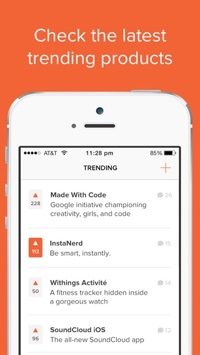
Product Hunt.
Product Hunt is an app to discover and share trending products, primarily in the technology space. Submit, vote, and bookmark your favorite products. Easily search for products. Follow the conversation with product followers and founders.
—
Wanelo
Wanelo (from Want, Need, Love) describes itself as a “mall on your phone.” Wanelo is shopping entertainment, bringing you a stream of unique products, all posted by users. Follow your favorite stores and people in one place to get a feed of products customized just for you. Products include fashion, clothes and accessories for women, men, and kids, as well as home decor and furniture. Use the app to create a wishlist.
—
Raise
Raise is an app to buy and sell gift cards. Access the Raise marketplace to find discounted gift cards to brands such as Target, The Home Depot, and Macy’s. Or use the Raise marketplace to sell gift cards for cash at the price you choose.
—
The Hunt
The Hunt is a community shopping app. Post a photo of what you’re looking for, and the community of shoppers will help you find it, style it, or buy it for less. See what’s trending, or use your shopping skills to recommend products to others.
—
Peach
Peach holds nine-minute private auctions for goods from designer brands. In these members-only auctions, products can have up to an 80 percent discount. Choose what you want to pay on an item. You always pay the second highest offer.
—
The Gadget Flow
The Gadget Flow is a platform that helps you discover cool products of the web, with 9 to 12 new products each day. It also provides you with the option of saving your favorites products in private or public wishlists for future use. Its mission is to find the coolest products on the web and present them to you without unnecessary clutter.
—
Threadless
Threadless is a company that sells community-chosen designs on clothing, like t-shirts and hoodies. Users can submit designs to Threadless, which are then voted on for a 7-day period by other users in the community. Once the scoring period has ended, the design receives a score from 1 to 5. This is used as a gauge by Threadless to decide what gets made.
—
Wish
Wish is a mobile commerce platform in North America and Europe, providing shoppers with deep discounts through Wish’s marketplace of primarily Chinese manufacturers. Browse a selection of trending fashion, accessories and electronics. The Wish app personalizes the user’s shopping experience, adjusting what products are shown based on browsing behavior. (We separately addressed Wish recently, at “Ecommerce Lessons from the Wish Shopping App.”)
—
Handy
Handy is an app to book and manage home cleaners and handymen, covering over 20 cities in North America, Canada, and the U.K. Handy is also a good example of a mobile commerce app for services. Specify what you need and when you need it, then pay securely right from your phone. Manage your bookings on the go, check the progress of your bookings, and rate the service.
—
Uber
Uber is an app to connect riders to drivers, retooling urban transportation. Uber is a good example of disruptive mobile commerce — enticing and empowering its mobile network with convenience and lower rates — in the face of the traditional taxi model. With Uber, compare rates for different vehicles and get fare quotes in the app. Get connected to your personal driver and check the progress of your Uber at any time.
—
Cover
Cover is a payment app that streamlines dining out. Pay for your meal without waiting for the check. Just join a table in the app and tell your server that you’re “paying with Cover.” Cover will leave the tip you choose so that you can go when you’re ready, without checking out. If you’re dining with friends, cover will automatically split the bill. Cover is currently available for restaurants in the San Francisco area, New York, and Salt Lake City.
—
Starbucks

Starbucks.
The Starbucks app is for payment and rewards. Pay for purchases, earn and manage reward points, find stores, tip baristas, download free weekly music, and more. However, the app’s true revolutionary quality is its widespread usage. According to a recent Business Insider article, the Starbucks app drives around 5 million transactions a week. The Starbucks app may be the best visible example of mobile commerce infiltrating our day-to-day lives.
—


